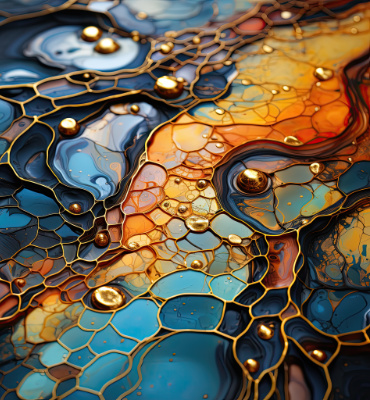The creation of Art is funded through: government, lottery or charity grants; scholarships; competitions; artist in residence schemes; patronage; or is self-funded.
As art and commerce becomes inextricably linked in our daily lives, so art looses its status and importance. The rich buy art as an assertion of their economic standing and good taste. Art is not an industry, although those who benefit from this idea would have you believe it...
You may be interested in viewing the work Stradivarius Liberatus at 100 Artworks which was created in response to a photo of a potato that sold for one million dollars.
Art becomes the fool's gold of our times...
Art is bought and sold, valued and devalued depending on the taste and whims of the paying consumer.
An artwork often compliments an existing environment: a corporate building, a person's home, a cultural establishment. The artwork must reflect the values and attitudes of the commissioning agent, it must present 'appropriate content', be the right size, shape, duration, colour, and produced using media that reflects and promotes the consumer's corporate, organisational, or personal persona.

As the interior world of the consumer changes, so the artwork is replaced. Art becomes disposable.
The primary emphasis of art has altered as the commercial art market has grown. Art for many is now often no more than fashionable decoration.
Art institutions, critics, administrators, agents, galleries and auction houses sell to buyers in a fine art marketplace that distances itself from what is considered the crass and vulgar sale of mass produced greetings cards, posters and prints available to the general consumer.
The role of the institution and expert in the art market is crucial in confirming to others who are not confident in their own critical or aesthetic judgments, that an artwork is worth a particular amount of money.
In this endeavour, the art market protects exclusivity above all else, as this drives prices ever higher. The art market seeks to exchange unique objects and avoids popular and public art.
With and Alone
The following extracts are from my collected thoughts With and Alone as they relate to Money and Art:
The Why Of What I Do
Most who make art have confidence what they make will be experienced by another. When that certainty weakens, when the context or hope to share is jeopardized, the creative urge declines.
Some pretend others want what is made by selling it. Commercial success requires the appeal to a broad audience, or a high price to an exclusive one. Commerce becomes the crutch for confidence.
Removing the exchange of money from my creative work helps me better know the why of what I do.
How What I Make Is Used
My ability to make money (at present something essential without inherited wealth) relies on how well my abilities match qualities that are of value in an economic context: self-confidence; commercial awareness; language skills; the comfort to ignore consequences - how what I do or make is used. Who is what I do or make sold to? This matters in the sale of art as much as any other field.
I care how I gain, how I am advantaged, and by what means I profit. I do not value art for its sale.
Art As Commodity
Commodity: something bought and sold.
A child dances spontaneously.
A child dances spontaneously and other children are moved to join, and dance.
A child dances spontaneously, beautifully. The dance is captured, sold, and broadcast.
The dance is now an expression of joy, and a commodity. To some this change transforms it into art.
The Business of Art · Acts of Love
Many view art as a business. Many artists view art as a business. An artist has to live. They have to buy food, support a family, pay for a roof over their heads. Some things are made to be sold.
Money changes what is made. To sell, I must make something that can be sold. If my focus is on the advantage I gain when I make something, I make it for myself.
Love is never sold. Love, by its nature, is given. Making art can be an act of love.
The Art of Making Money
A well known self-publicist, entrepreneur and serial pretender of the title artist is once again adding to his considerable personal wealth with his new show. A collection of noted paintings in an eighteenth century mansion have been replaced in situ by roundish marks of paint on canvas created by anonymous hired painters who are required to apply an average of 1,500 spots a day.
Words and placement assert this as art, characterized by exploitation, ridicule, and greed.
Money and Work
A job requires payment. Work does not. The value of work someone does has nothing to do with money.
Many define their status and success by the amount of money they earn rather than the non-economic outcomes of their work. It is unfortunate the same is true for many who create art.
A parent may work far harder in their care of a child, than their partner does in their job. That one earns money and the other does not has absolutely no relevance to the significance and impact of their work.
Ownership and Advantage
Buying and selling is the transaction of seeking ownership and advantage.
As my creative work is freely available, it is not scarce, exclusive, nor the subject of special offers.
People who encounter my work and have money are on the same level playing field as those who do not. Emotion and thought is not focused on the acquisition of the content I make, but on its experience.
Art belongs in us rather than to us. I posses art on the inside, not my outside.


